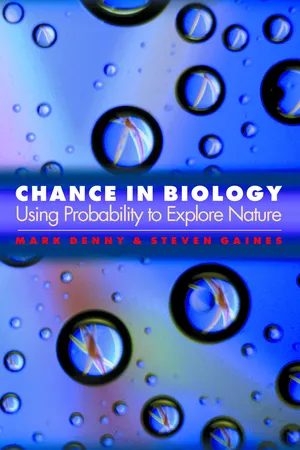
- 312 pages
- English
- ePUB (mobile friendly)
- Available on iOS & Android
About This Book
Life is a chancy proposition: from the movement of molecules to the age at which we die, chance plays a key role in the natural world. Traditionally, biologists have viewed the inevitable "noise" of life as an unfortunate complication. The authors of this book, however, treat random processes as a benefit. In this introduction to chance in biology, Mark Denny and Steven Gaines help readers to apply the probability theory needed to make sense of chance events--using examples from ocean waves to spiderwebs, in fields ranging from molecular mechanics to evolution.
Through the application of probability theory, Denny and Gaines make predictions about how plants and animals work in a stochastic universe. Is it possible to pack a variety of ion channels into a cell membrane and have each operate at near-peak flow? Why are our arteries rubbery? The concept of a random walk provides the necessary insight. Is there an absolute upper limit to human life span? Could the sound of a cocktail party burst your eardrums? The statistics of extremes allows us to make the appropriate calculations. How long must you wait to see the detail in a moonlit landscape? Can you hear the noise of individual molecules? The authors provide answers to these and many other questions.
After an introduction to the basic statistical methods to be used in this book, the authors emphasize the application of probability theory to biology rather than the details of the theory itself. Readers with an introductory background in calculus will be able to follow the reasoning, and sets of problems, together with their solutions, are offered to reinforce concepts. The use of real-world examples, numerous illustrations, and chapter summaries--all presented with clarity and wit--make for a highly accessible text. By relating the theory of probability to the understanding of form and function in living things, the authors seek to pique the reader's curiosity about statistics and provide a new perspective on the role of chance in biology.
Frequently asked questions
Information
Table of contents
- Cover
- Title
- Copyright
- Contents
- Preface
- 1 The Nature of Chance
- 2 Rules of Disorder
- 3 Discrete Patterns of Disorder
- 4 Continuous Patterns of Disorder
- 5 Random Walks
- 6 More Random Walks
- 7 The Statistics of Extremes
- 8 Noise and Perception
- 9 The Answers
- Symbol Index
- Author Index
- Subject Index